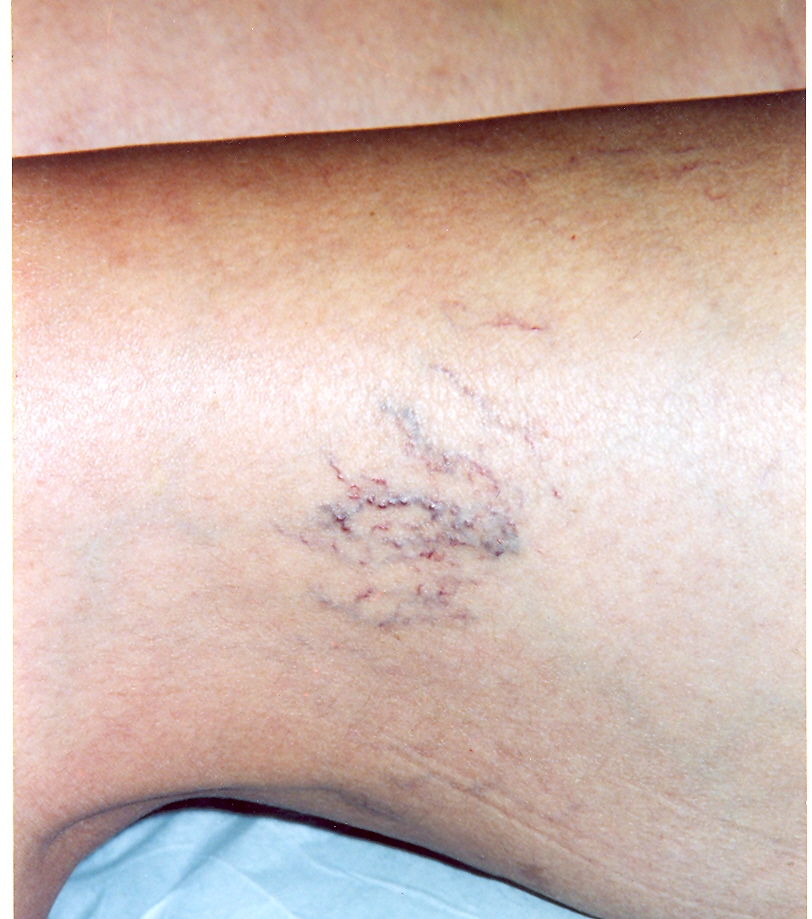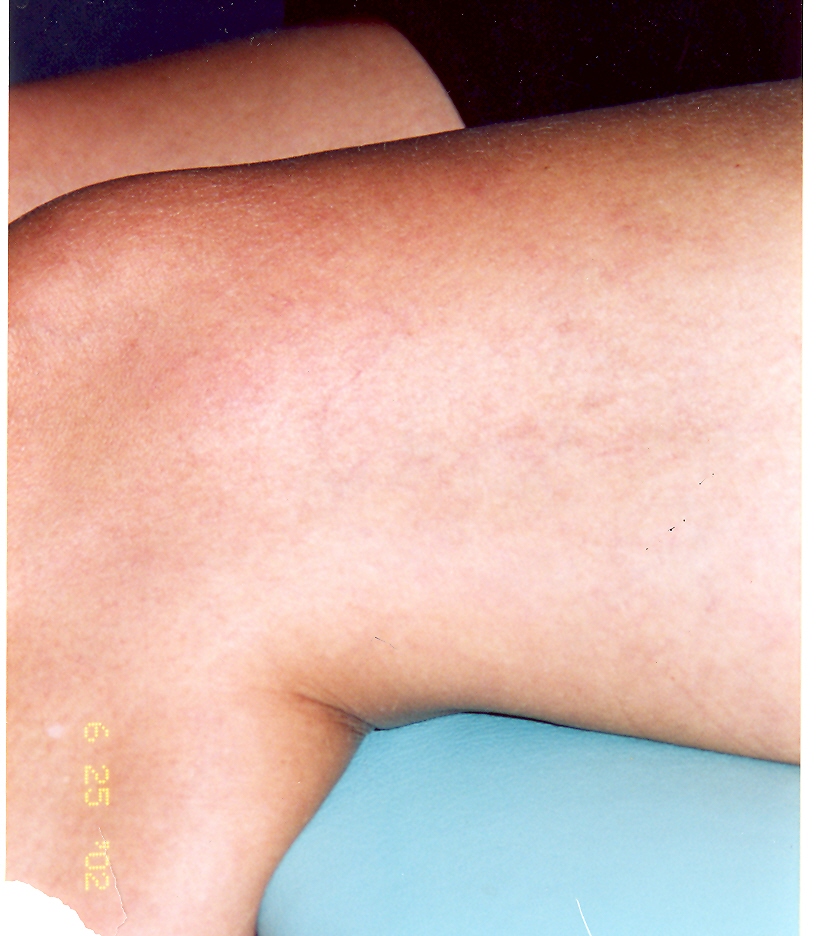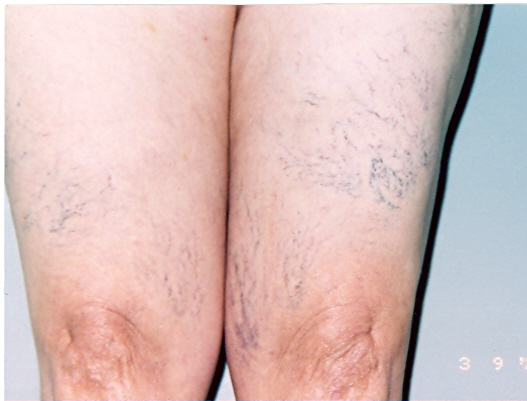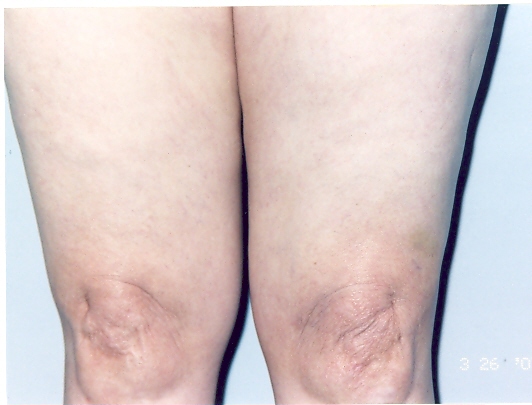|
What is Sclerotherapy?
Sclerotherapy is the technique in which a specific solution is injected with a very fine needle directly into the vein. This procedure has been used since the 1920's. The solution irritates the lining of the vein, causing it to swell and stick together. The body in a natural healing process then absorbs the vein over period of weeks. This does not harm the circulation, but improves it by eliminating the abnormal, unnecessary vessel.
How is Sclerotherapy done?
Sclerotherapy is performed in the office. After signing a consent form authorizing the center to treat your condition, the skin of the area to be treated is cleansed with alcohol. A very fine needle is in inserted in the vein, and a solution injected directly into the vessel. At this point, you may experience mild discomfort, especially when larger veins are injected. Pressure is applied over the treated vein with cotton & tape. At the end of the session, the leg is wrapped with a bandage & compression support stocking are worn.
The procedure itself takes approximately 15 to 30 minutes. To feel more comfortable, you should plan to wear shorts during the session. Depending on its size, a single blood vessel may have to be injected more than once, some weeks apart, but in any one-treatment session a number of vessels can be injected. The solution and concentration used vary somewhat with the size of the vessel to be injected. Only FDA approved medications are used for the treatment.
How many veins are injected and how many sessions will I need?
The number of veins injected in one session varies, depending on the size and location of the veins, as well as the general medical condition of the patient. The number of sessions needed to clear all your veins depends on how extensive and how far advanced your condition is.
Is Sclerotherapy painful?
Injection is performed with a very fine needle, the size of a hair. Most people describe it as a mosquito bite. The solutions we use for treatment are not painful and do not cause any burning sensation as experienced with salt (concentrated saline) injections. If you have needle phobia or have very low threshold for pain, then we recommend a topical anesthetic cream, applied for 45 to 90 minutes to the area to be treated.
Am I a candidate for Sclerotherapy?
Micro Sclerotherapy can be used on all skin colors. It is best suited for spider veins and small varicose veins. However, larger varicose veins can be safely and effectively treated with foam compression sclerotherapy and ultrasound guided treatment especially if the underlying cause of varicose veins is identified and treated.
You are not eligible if you are:
|
|
Pregnant |
|
|
Have limited mobility or bedridden |
|
|
Have poor arterial circulation (Peripheral Arterial Disease) |
|
|
Prone to have blood clots (hypercoagulable state) |
|
|
Has skin infection at the area to be treated |
You can have Sclerotherapy if you take birth control pills. If you have had a blood clot in the past, your eligibility will be decided on an individual basis, and will depend on the overall health of the area needed to be treated as well as the reason for the clot.
How successful is Sclerotherapy and how soon will I see results?
Sclerotherapy relieves symptoms due to varicose and spider veins in most patients. With this procedure, veins can be dealt with at an early stage, helping to prevent further complication.
Fading of the treated vessels is gradual and a slow process. In general, spider veins respond to treatment in 3 to 6 weeks, and larger veins respond in 3 to 4 months. The majority of people, 75% to 90%, who have Sclerotherapy performed, will be cleared of their veins or at least see significant improvement. Unfortunately, however, approximately 10% of patients who undergo Sclerotherapy have poor to fair results ("poor results" means that the veins have not totally disappeared after six treatments).
|
|
|
|
Before Sclerotherapy
|
After Sclerotherapy
|
|
|
|
|
Before Sclerotherapy
|
5 Years After
|
Will my veins recur?
If the veins respond to the treatment, they will not reappear. However, this treatment does not prevent new veins or telangiectasias from developing over the coming years. Additional treatments are generally required in the future for optimum and lasting results. Recurrences may rarely occur over a period of 1 to 5 years.
Are there certain vessels which tend to recur more commonly?
Yes. They are the types of vessels, which occur in a mat of very fine red radiating vessels. These are best treated with a combination of Sclerotherapy & Laser or IPL.
What are the side effects of Sclerotherapy?
Side effects of Sclerotherapy include: Stinging or pain, Bruises and discoloration, brown lines or spots on the skin (hyperpigmentation), development of small mats of fine red blood vessels near the site of injection (Matting), inflammation of injected blood vessels, tender lumps in injected blood vessels particularly large ones. Serious complication such as clots in the deep veins, ulceration, and severe allergic reaction to medications are extremely rare.
What shall I do before the treatment?
Do not take aspirin, ibuprofen, or other nonsteroidal anti-inflammatory drugs (e.g., arthritis medicine - Advil, Alleve, Naprosyn) for 5-7 days before your treatment because these medications can increase bruising. Tetracycline or Minocin, both antibiotics, may possibly cause a staining of the skin if taken 7 to 10 days before or after Sclerotherapy
Before your appointment, shower and wash your legs thoroughly with an anti-bacterial soap. Do not shave your legs the day of the appointment to avoid discomfort. Do not apply any cream or lotion to your legs.
Bring loose fitted shorts or a leotard to wear during a treatment. Eat a light meal or snack 1-½ hours before your appointment.
What shall I do after the treatment?
|
|
Do not use Aspirin or Ibuprofen for 5-7 days after each treatment to reduce bruising unless prescribed to you by the office. Acetaminophen (Tylenol) can be used as needed.
|
|
|
Immediately after your procedure, you are required to put on Support Stockings and walk for 10 to 30 minutes. Be sure to have loose-fitting slacks and comfortable walking shoes with you. |
|
|
Leave support stockings, brown tape (Ace Bandage when present), White bandage, and Cotton balls for 48hs or as instructed. To take a shower, place a plastic bag over the bandage. The longer the bandage stays in place, the better. |
|
|
Wear support stockings thereafter during the day, remove before going to bed. |
|
|
Please notify the office if you experience any of the following over the treated area:
| |
 Any sores (open skin) Any sores (open skin)
 Excessive unusual pain Excessive unusual pain
 Significant swelling of the treated leg Significant swelling of the treated leg |
|
|
|
Slight itching, stinging, or burning may occur at the site of injections. This usually lasts for short period. If persists over few hours or symptoms are severe, take one tablet (25mg) Benadryl, use cortisone ointment as prescribed or call the office. |
|
|
You may experience pain at the site of injection especially if the injected vein is large. The vein may be tender to touch. This is usually temporary and lasts one to three weeks. |
|
|
Mild swelling at the ankle may occur especially after injecting foot or ankle veins. It usually resolves in few days. |
|
|
Maintain normal activities. Walk at least 1 hour a day - the more, the better! |
| |
Avoid standing without moving for long periods. If you must stay in one place, move your feet and toes frequently. |
|
|
Do not take hot baths or sit in a whirlpool or sauna, nor apply hot compresses or any form of heat to the injected areas for 48 hours after treatment. In addition, avoid direct exposure to sunlight (sun bathing and tanning beds), jogging, high-impact aerobics, weight lifting and swimming for 7 to 10 days after the procedure. |
|
|
Showers are permitted, but the water should be cooler than usual. The injection sites may be washed with a mild soap and warm water. Cool your legs with cold water after each shower |
|
|
Wear support stockings between treatments. After healing, use them for long trips or when your legs ache. The more you use them, the better. |
|





 Any sores (open skin)
Any sores (open skin)